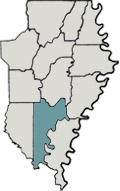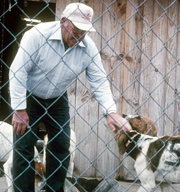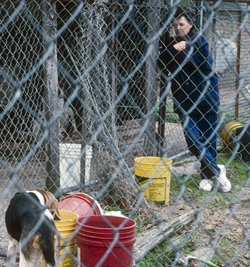Introduction to Delta Pieces: Northeast Louisiana Folklife
Map: Cultural Micro-Regions of the Delta, Northeast Louisiana

The Louisiana Delta: Land of Rivers








Ethnic Groups










Working in the Delta








Homemaking in the Delta




Worshiping in the Delta



Making Music in the Delta




Playing in the Delta







Telling Stories in the Delta



Delta Archival Materials
Bibliography

Moses Poole
Catahoula Parish
Moses Poole is a retired state forestry worker hunting with Walker hounds.

Moses Poole on Pen Hunting in Catahoula Parish: "You've Got to Know Your Dog's Mouth"
By Marcy Frantom
Fenced pen hunting with dogs is a newer sport in the Southern states that arose during the 1960s when timber and paper companies closed their landholdings to free public hunting. Fox and coyote hunters now lease large fenced properties giving them exclusive access to the land for a fee; timber and paper companies get better stewardship of their lands. The result is a change in the traditional practice of fox hunting according to hunter, breeder, and trainer Moses Poole. This Aimwell man pitched in and helped other local hunters adapt a former Depression-era Civilian Conservation Corps (CCC) camp into a set of fox pens.
Moses Poole is a retired state forestry worker hunting with Walker hounds since his return to the parish in 1954 after brief employment in Texas and Oklahoma. During the Depression, Poole's father night-hunted bobcats and coons with mixed breed dogs to sell the pelts, and during the day, young Moses took the dogs rabbit hunting for meat. He learned much of what he knows about hunting and hounds on his own and earned a reputation among hunters for breeding and training pedigreed Walker hounds. His dogs have won two state competitions. While his wife is knowledgeable about fox hunting and attends pen social events, she hopes none of their three boys take up the sport. However, dogs are a family passion and the couple already engraved an image of their favorite hound, Parrot, on their joint tombstone.
Although Poole hunts twice a week throughout the year, he most enjoys the annual competitions at the Louisiana Pride Fox Pen near his home with the chance to prove his dogs and often is asked to judge. The pen holds fox hunting events in April and October. Members compete in hunting horn blowing contests while their hounds are judged for hunting performance in field trials and physical appearance in bench trials. "Top dogs" are eligible to compete in the "International Running Hound Hunt" which was held in Aimwell twice.
The Louisiana Pride Fox Pen is owned by International Paper Company and consists of two pens-a small 100-acre one for day hunting used mostly by amateurs and for starting puppies, and a large 800-acre one for night hunting and competitions. The hunters sit in a centrally located tin building that has one side open so they can hear the dogs. During the competition, hounds are rated for speed, drive (enthusiasm), and, more rarely due to the nature of restricted game in the pen, hunting (scouting and looking for game) and trailing (upon finding the game, pursuing it vigorously and barking). Hunting and trailing scores are only awarded if the "race breaks down," that is, the hounds lose the scent which rarely happens in the pens because, as Poole explains, "The hounds just run down the trail until they jump another fox or coyote."
Fox hunting in Aimwell, Catahoula Parish, Louisiana, may be an offshoot of the traditional English sport; however it is very different. For example, Victorian English novelist Surtees describes the end of a fox hunt in 1853: "Mr. Puffington then presented Mr. Sponge with the brush [fox tail signaling the end of the hunt], and the usual solemnities being observed, the sherry flasks were produced and drained, the biscuits munched, and, amidst the smoke of cigars, the ring broke up in great goodwill" (113). On the other hand, an example of a fox hunting event at the Louisiana Pride Fox Pen in Aimwell might show members of Camp Swan sipping coffee from thermos bottles, chopping wood to build a warm fire beside the tin shelter, and pausing to listen to the "music" of the hounds trailing a scent through the night fox pen. Poole says no fox tails are presented-game is chased rather than hunted in the ordinary sense of the word, and hunters make every effort to preserve the lives of the prey.
Early fox hunting in America featured wealthy Easterners who imported the European red fox because the native gray fox does not provide as long or complicated a chase (Trigg 62). The sport of foxhunting "at an early date, permeated the states of Georgia, the Carolinas, Kentucky, and Tennessee" (62). The main difference, Trigg notes, between hunting practices in the North and South by 1890 was that Southern foxhunters did not kill the game, as Northern hunters did (68). The red fox migrated South as early as 1860 (Trigg 70), and is now found all over the United States (Hufford 165).
Folklorist Mary Hufford identifies two distinct foxhunting traditions in the United States: the formal English style and a mixed class style known as "hilltopping." She explains: "The former hunters 'ride to the hounds' on horseback, while the latter 'listen to the hounds' around campfires or in their pickup trucks" (178). Foxhunting in Catahoula Parish is definitely the hilltopping variety; Poole states, "A true hunter wants to listen and observe [by hearing] what's going on."
The pleasure of fox and coyote hunting is listening to the voices of the hounds and identifying which dog is in the lead. Poole explains: "You've got to know your dog's mouth. Some dogs' mouths blend in with the pack and are indistinguishable. That's all right; they just help to make the music. But what I like and breed for is a big, heavy mouth. I want him to stay on the front end, with a burning desire for pursuit." A good musical ear is required of the hunter: "Each hound has its own 'note,' whereby it transmits information about the fox to its owner: what kind of fox it is, what kind of terrain they are in, which dogs are in the lead, or whether the fox has tricked them yet again. The fox is like the conductor of a symphony" (Hufford 180). A number of folk songs have been composed on the subject, including "The Fox Chase," "Mountain Fox Chase," and "Fox on the Run" (Hufford 180-81).
Moses Poole believes fox hunting regained popularity during the 1930s when wild game was hunted almost to extinction in North Louisiana during the Great Depression. The State banned deer hunting, imported white-tail deer from Texas, and made every effort to help the natural population increase to acceptable levels so meat hunting could resume. Sandel agrees that the same thing happened in Western Louisiana during this period--fox hunting became a passion for rural men-and that occurred because of the absence of edible game (26). Poole says the deer season was closed for five years for restocking in Catahoula Parish and he "had to train [his] dogs off of deer."
After World War II, Louisiana woodlands were increasingly owned and controlled by timber and paper companies, but their property rights were considered unenforceable until they developed the leasing system. In this system, a group of hunters contract to make improvements and perform maintenance on a property, promising to restrict their use. Moses Poole identifies land leasing, which began in the 1960s, as what stopped open field fox hunting. Still deer hunters sitting on stands are incompatible with dog hunters, he says. Unfortunately, there are many more still hunters than fox hunters paying low lease fees, but larger numbers of them can be accommodated on given tracts of land. Leasing land to still hunters makes more money for the land owners than fox pens, with their low memberships and high fencing investments, do.
Moses Poole complains that hunting pens are affecting what traits hunters encourage and breed for in their dogs.
Dogs in pens don't hunt like they used to. You put them in the pen, and they're running wide open down one of these trails until they run into the scent. That's the only way they know how to hunt now. If you put one in the open, it wouldn't know what to do. You see, real fox or wolf hounds, when they lose the scent, the whole pack will fall silent until they're on the trail again. They know when to bark and when not to. He says that hounds are now bred only for speed, since that is what they are judged for in the pen. Changes in competition rules to allow for pens water down the art of fox hunting: "All they [hunters] want to do is see that dog run in front of the judge. It doesn't matter if he's barking [at the wrong time] or how he got there; they just want to get the score."
Poole says the Walker hound is the most popular breed because of its speed and endurance. These hounds were developed by the Walker brothers of Kentucky before the turn of the century. In 1890, Haiden C. Trigg explains why the Walker hound and other breeds were necessary:
This country requires a different dog from England. There, the land is nearly all in a high state of cultivation . . . . With us we must have dogs of superior nose and better ranging qualities that will go a great distance in our immense woodlands in quest of the game. The large English hound of the same speed in the open would be outfooted by our smaller American dog in the briar-fields and heavy undergrowth of our forests. (62)
Other traditional breeds are the July hound, noted for speed but less endurance, and big game dogs such as the Black and Tan, Redbone, and Blue Tick. Poole says these "were designed to hunt mountain lions. They work the trail slowly and are more vicious at attacking game than the Walker hound is."
Fox hunting pens also offer coyotes as a new challenge for hunting hounds when these can be found, trapped, and relocated inside the enclosure. Poole remembers the first coyote he found in the 1960s, when hunting "on the outside" was still permitted by the timber companies:
We didn't even know they were in this country. I was running my dogs one night when all the hair stood up on one of the dog's back, and he ran past me. I stopped the truck and, right around the bend, the coyote was just howling. So, I opened up the gate and let all the dogs go. I was three days gathering up my dogs; they got away from me. That's when I started running coyotes; I didn't fool around with the gray fox anymore. They go round and round, and don't go very far. Every once in a while, I'd find a coyote, I call them "gas burners," that would go all over the country. He'd take you somewhere, down those haul roads and cow trails! Oh, man, you talk about a pack of hounds running one!
Poole traps coyote for the pen using a soft rubber trap and bait. Once placed inside the pen, the coyotes are fed in large wooden boxes that have holes large enough for them, but not the hounds, to crawl inside. Fox hunters are always on the lookout for coyote and wolf dogs willing to "go in on" a coyote rather than simply follow him. Poole obtained some wolf dogs for breeding purposes; however, he says, "I got them home and found out they were just like my dogs-cowards!"
A number of other pens exist in the state: Effie, Leesville, Jonesboro, and Bastrop, some of which are also leased from timber companies. Fox and coyote hunters must travel to alternate pens to keep their hounds from "getting too smart" and "cheating" on the hunt, according to Poole. Hunting in pens is expensive because of pen fees and transportation costs-this has reduced the number of hunters who can afford the sport.
Although Catahoula residents once hunted in the open fields and forests, fox hunting as a sport was forced to change to survive. Land leasing restricted the free run of hunters and hounds, and fox hunters became pen hunters. On the positive side, pen hunting allows the Aimwell men to enjoy some of their most valued parts of the hunting camp experience-an opportunity to gather, swap stories, and listen to the "music" of the hounds. Moses Poole remembers: "It's been a tradition for years and years, even before my time, that people in this country ran hounds. Now, since the deer hunting clubs, all we've got is the pens. That's sad, but that's the way it is . . . . But I've enjoyed my life, and I've had a lot of years hunting on the outside, so I don't regret just having the pens now."
Works Cited
Gough, Lionel, ed. Hunting Scenes From Surtees. London, England: Rupert Hart-Davis, 1953. Print.
Hufford, Mary. "The Fox" in American Wildlife in Symbol and Story. Angus K. Gillespie and Jay Mechling, eds. Knoxville, TN: University of Tennessee Press, 1987. Print.
Poole, Moses. Interview by Marcy Frantom. 5 Jan. 1994.
Sandel, Luther. The Free State of Sabine and Western Louisiana. Many, LA: Jet Publications, 1982. Print.
Trigg, Haiden C. The American Fox-Hound. Privately printed (1890). Reprinted in The Hunter's Horn Jan. 1978. Print.





